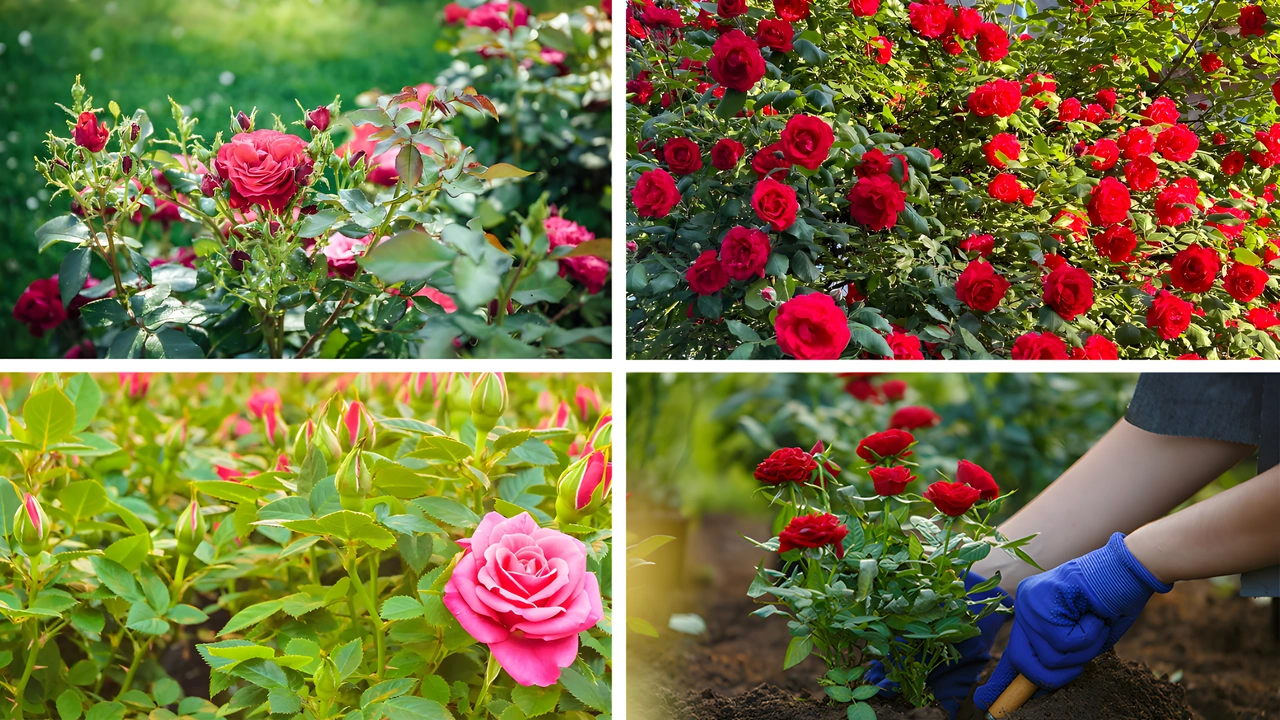Join on WhatsApp
Get the latest updates directly on WhatsApp – motivation, news & more!
Roses are one of the most cherished and timeless plants in any garden, but they can also be surprisingly delicate. Many gardeners—beginners and seasoned growers alike—unintentionally make mistakes that lead to weak growth, pest infestations, or even dying rose bushes. This article breaks down the 9 costly mistakes that are slowly killing your rose bushes and provides expert tips to bring them back to life, so you can enjoy vibrant blooms season after season.

Whether your roses are failing to flower or showing signs of disease, understanding these common errors can help you take corrective action. Don’t let poor pruning or bad soil choices ruin your rose garden—learn how to rescue your plants with proven, practical advice.
1. Overwatering: A Common Mistake That’s Slowly Killing Your Rose Bushes
Overwatering is one of the most costly mistakes that are slowly killing your rose bushes, especially when the soil doesn’t drain well. Roses hate sitting in soggy soil, which suffocates their roots and leads to root rot—a silent killer.
Expert Tip to Bring Them Back to Life: Only water your roses when the top 1–2 inches of soil feel dry. Deep watering once or twice a week is better than daily shallow watering. Ensure the area has good drainage, or amend heavy soil with compost and sand to allow water to pass through more freely.
2. Planting Rose Bushes in the Wrong Location
Improper placement is another costly mistake that’s slowly killing your rose bushes. Roses love sunlight, and planting them in too much shade weakens the plant, encourages fungal diseases, and results in fewer blooms.
Expert Tip to Bring Them Back to Life: Choose a spot that gets at least 6–8 hours of direct sunlight each day. If your rose bushes are in a shady location, consider transplanting them during the dormant season to a sunnier part of your garden.
3. Poor Pruning Practices Are Damaging Your Rose Bushes
Improper pruning—or failing to prune at all—is among the most common and costly mistakes that are slowly killing your rose bushes. Pruning too late or too harshly can weaken the plant, while not pruning at all invites pests and diseases.
Expert Tip to Bring Them Back to Life: Prune in early spring when new buds are forming. Always cut at a 45-degree angle about ¼ inch above an outward-facing bud. Remove all dead, damaged, or crossing branches to improve airflow and reduce disease risk.
4. Ignoring Soil Quality and pH Balance Is Slowly Killing Your Rose Bushes
Soil that is too acidic, too alkaline, or lacking in essential nutrients is a hidden mistake that’s slowly killing your rose bushes. Roses prefer a slightly acidic soil pH between 6.0 and 6.5. Poor soil health can lead to yellow leaves, stunted growth, and minimal flowering.
Expert Tip to Bring Them Back to Life: Test your soil with a pH kit. If it’s too alkaline, add elemental sulfur. If it’s too acidic, add lime. Improve soil fertility with compost, aged manure, or a balanced slow-release fertilizer designed for roses.
5. Neglecting Pest Control Is One of the Costly Mistakes Killing Your Rose Bushes
Aphids, spider mites, and Japanese beetles are just a few of the pests that can invade and wreak havoc. Ignoring these tiny invaders is a costly mistake that’s slowly killing your rose bushes.
Expert Tip to Bring Them Back to Life: Inspect your plants regularly, especially the undersides of leaves. Use insecticidal soap or neem oil as a natural remedy. For severe infestations, consider introducing beneficial insects like ladybugs or applying systemic insecticides.
6. Allowing Fungal Diseases to Spread Unchecked
Fungal issues like black spot, powdery mildew, and rust are rampant problems for roses. Ignoring early symptoms is a costly mistake that could be slowly killing your rose bushes.
Expert Tip to Bring Them Back to Life: Practice preventive care by watering at the base of the plant (not overhead) and ensuring good air circulation. Use a fungicide as soon as you spot symptoms, and remove and dispose of affected leaves to prevent spreading.
7. Using the Wrong Fertilizer—or Too Much of It
Applying too much nitrogen-heavy fertilizer results in lush foliage but few blooms. This is one of the costly mistakes that’s slowly killing your rose bushes from within.
Expert Tip to Bring Them Back to Life: Choose a balanced fertilizer or one specially formulated for roses (e.g., 5-10-5). Apply it in early spring and again after the first bloom cycle. Avoid feeding after mid-summer to prevent late-season growth that’s vulnerable to winter damage.
8. Skipping Mulching Can Slowly Kill Your Rose Bushes
Skipping mulch or using the wrong kind is a surprisingly costly mistake that’s slowly killing your rose bushes by allowing weeds, temperature fluctuations, and moisture loss to take their toll.
Expert Tip to Bring Them Back to Life: Apply 2–3 inches of organic mulch (like bark, shredded leaves, or straw) around the base of your rose bushes. Keep the mulch a few inches away from the stem to prevent rot.
9. Failing to Deadhead Spent Blooms Is Hurting Your Rose Bushes
Not removing old, spent blooms is one of the most overlooked costly mistakes that’s slowly killing your rose bushes. It signals the plant to produce seeds instead of new flowers.
Expert Tip to Bring Them Back to Life: Deadhead by cutting the stem just above a five-leaflet leaf set. This encourages repeat blooming and helps the plant focus its energy on producing fresh, healthy flowers.
Quick Reference Table: 9 Mistakes That Are Killing Your Rose Bushes and How to Fix Them
| Mistake | How It’s Killing Your Roses | Expert Tip to Bring Them Back to Life |
|---|---|---|
| Overwatering | Causes root rot | Water deeply only when topsoil is dry |
| Planting in the wrong location | Lack of sunlight weakens plant | Ensure 6–8 hours of direct sunlight |
| Poor pruning | Encourages disease and poor growth | Prune in spring, cut above outward-facing buds |
| Ignoring soil pH and quality | Leads to nutrient deficiencies | Test and amend soil with compost and proper pH adjustments |
| Neglecting pests | Leads to leaf damage and poor growth | Use neem oil, inspect regularly, attract beneficial insects |
| Allowing fungal infections | Spreads quickly and weakens plant | Improve air circulation, use fungicide at first sign |
| Using wrong or too much fertilizer | Promotes leaves, not blooms | Use rose-specific balanced fertilizer in moderation |
| Not mulching | Causes water loss and weed growth | Apply 2–3 inches of mulch, avoiding direct stem contact |
| Not deadheading blooms | Prevents new flower production | Deadhead regularly above five-leaflet set |
How to Identify If These Mistakes Are Slowly Killing Your Rose Bushes
Now that you know the 9 costly mistakes that are slowly killing your rose bushes, it’s crucial to observe your garden regularly. Yellowing leaves, leggy stems, lack of blooms, and spotting on foliage are all signs that something is wrong. Ignoring early symptoms often makes recovery more difficult.
Check soil moisture, monitor pests, and prune correctly. Don’t be afraid to dig a little to inspect the roots or move the plant to a better spot if needed. Every rose bush is salvageable if you act with care and timely intervention.
9 Costly Mistakes That Are Slowly Killing Your Rose Bushes and Expert Tips to Bring Them Back to Life – Final Thoughts
Your roses don’t have to suffer or die due to avoidable gardening habits. Understanding these 9 costly mistakes that are slowly killing your rose bushes—and applying the expert tips to bring them back to life—can transform a struggling plant into a flourishing beauty. From proper watering and sunlight to pest control and deadheading, each step plays a role in reviving your rose bushes and sustaining their long-term health.
The key is consistent care, observation, and a willingness to adapt your gardening routine. With this guide, your rose bushes won’t just survive—they’ll thrive, rewarding you with season after season of stunning blooms.


